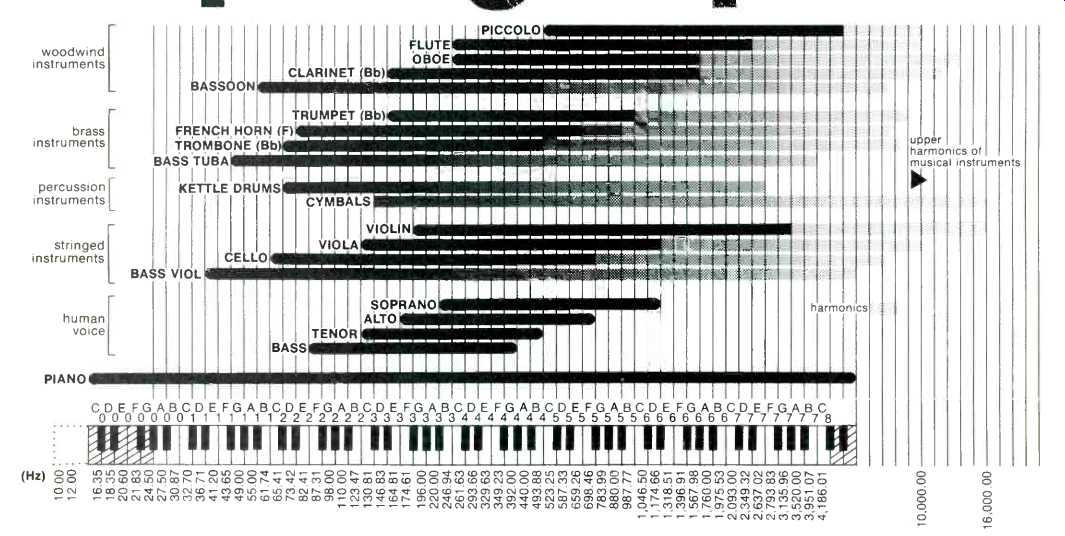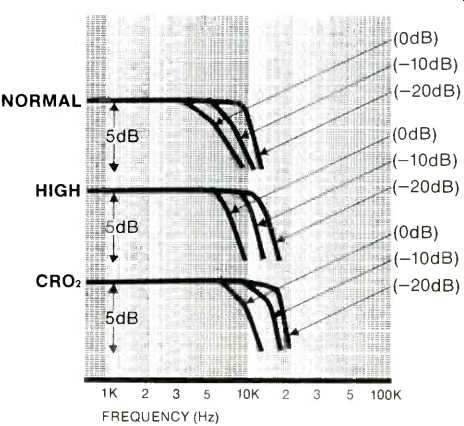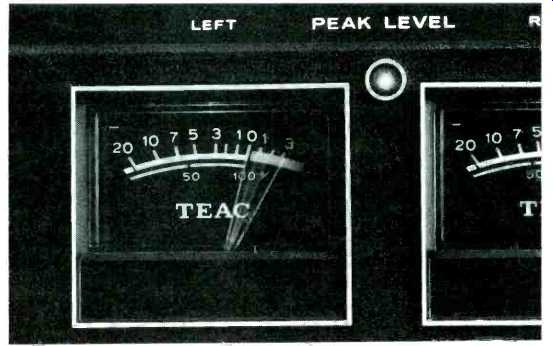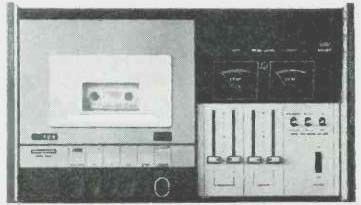Some in infrequently-known facts about frequency response

(above) Chart 1. Frequency ranges of musical instruments and the human voice.

Chart 2. An approximation of "pressure levels" of various types
of orchestral music.
(This is a guideline chart, naturally subject to variables of orchestration, miking and mastering equalization.)
1. Electronic music (rock, underground and synthesized)
2. Semi-electronic music (pop-rock, some country-western and contemporary jazz)
3. Average "normal" acoustic orchestra (classic, semi-classic, "easy-listening" and jazz)

Chart 3. Showing high-end frequency-response loss at various dynamic levels,
and comparing this phenomenon for different tape formulations. (Note: Tape
response characteristics will vary somewhat from brand to brand, and machine
to machine).
Audio buffs are discovering that even with increasingly sophisticated equipment, their recordings sometimes lack high-end frequency response. Despite your careful attention to recording levels, as shown on the meters, this high-end roll off can occur with all decks-reel-to-reel and cassette and at all recording speeds. However, it is more evident in cassette recording. It results from a phenomenon of tape called "saturation." Once you understand the cause, the cure is simple.
High-end frequency response losses occur when the head is unable to impress on, or retrieve from the tape's oxide particles the shorter wave lengths of the signal. In other words, when the wave length is actually shorter than the gap in the playback head, the head is simply unable to detect the signal. Increasing the record levels past this point demands more of the oxide particles than their magnetic properties permit, and distortion and saturation occur. However, this phenomenon, while somewhat due to the limitations of tape, is to a great extent a function of speed.
To put it another way: tape can only take so much high-end at high levels before losing response. Let's look at some reasons.
7 1/2 is longer than 1 7/8
With reel-to-reel, all the information in one second of time is distributed over 7 1/2 inches of oxide particles. In the case of cassettes, this identical amount of information must be contained within 1 7/8 inches of oxide particles. Thus, cassette tape flowing slowly at 1 7/8 is more vulnerable to revealing distortion and high-end saturation. Reel-to-reel tape flowing at 7 1/2 ips is much more "forgiving;" the magnetic fields are longer, and these aberrations of the signal tend not to be revealed.
How music differs from music.
Most "normal" music--that is, classical and jazz recorded with acoustic instruments--is well within acceptable levels, and there is little danger of saturation. However, rock and the "new music" recorded with electronic instruments are loaded with high frequencies at excessively high levels.
Look out. This is where a cassette transfer made at a "normal" -4 to 0 VU will saturate. Back off to around -8 to -4.
Chart 2 shows the "pressure levels" of various types of music. A normal acoustic orchestra shows normal pressure levels, with a "natural" rolloff at the high end. (Natural harmonics at 15 kHz are generally down over 20 dB). This orchestra acts as a natural filter, and high-end loss will not be a problem.

However, look at the contours of pop and electronic music; these high frequency, high-level signals will saturate quickly at 1 7/8. So back off to a level that will give you a satisfactory compromise between frequency response and signal-to-noise. Remember, contemporary music puts extraordinary demands on cassette decks, so keep cassette limitations in mind. To help you avoid high-frequency loss, TEAC suggests you consider some not-so-evident facts:
Level meters and TEAC's LED: guides, not gods.
Any type of meter is a limited instrument. It cannot respond accurately to transient highs those sharp, high-level sounds that last a fraction of a second, just long enough to saturate your tape. For this reason, TEAC has a Light Emitting Diode (LED) as featured on our top-of-the-line stereo cassette decks, to help you avoid tape saturation. TEAC's LED will supplement the meters by giving you an instantaneous peak-level indicator.
When the LED flashes, you're saturating-regardless of what your meters are telling you. The LED should be your overriding guide; if it is flickering and your music characteristically has high frequencies at high levels, back off 2 to 5 dB on your meters. However, with "normal" music an occasional LED flicker is tolerable. Remember, your meters and LED are indicators, not controls. Look at Chart 3 showing high end drop-off at various levels. You'll not that chromium dioxide tape resists saturation, somewhat more than the new ferric oxides which saturate at a lower level, and normal ferric oxides saturate at a lower level yet.

The ultimate input: your own creativity and judgment.
There are compromises to be made all down the line, and your personal taste is the final arbiter. If you're not getting good frequency response, analyze the elements we've discussed. Then experiment. Make a test recording, backing well off on your meters to keep your LED from flickering (but not so far that on playback level you bring up "hiss" and suffer signal-to-noise loss). Regardless of what the ads say, even the finest equipment has limitations. Learn them.
Remember, saturation isn't normally caused by your tape deck--it's caused by a combination of the music, the tape and your judgment.
TEAC's LED is one guide we've developed to help you enjoy your equipment. Like every new TEAC feature, it was designed as a problem-solver-an extension of the TEAC leadership philosophy.
(And if you want any other information on improving your recording techniques, write us. We'll be happy to discuss them with you). Enjoy your tape deck. And remember-use your wrist. It's good for your ear.
TEAC Corporation of America Headquarters: 7733 Telegraph Road Montebello, California 90640
TEAC offices in principal cities in the United States, Canada, Europe, Mexico and Japan.
TEAC®

The sound of a new generation
( Audio magazine, Apr. 1973)
Also see:
TEAC Model 3340 4-Channel Simul-Sync Tape Deck (ad, Feb. 1973)
TEAC 3300 open-reel tape deck (ad, Jan. 1973)
TEAC -- Open reel tape recorder technology (Feb. 1979)
TEAC -- Open reel tape recorder technology (Sept. 1979)
Crown tape recorders (ad, Apr. 1973)
= = = =